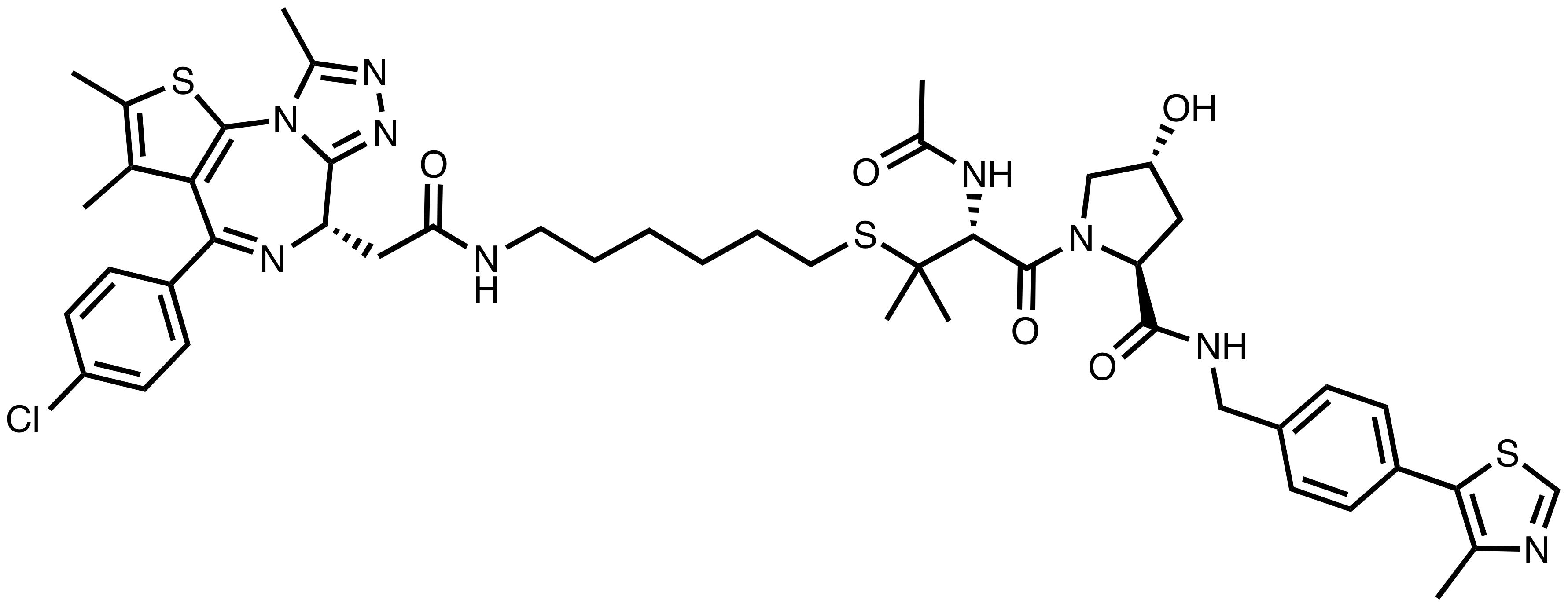
AT1
Protein Target(s) Name: BET protein BRD4
Mechanism of Action: PROTAC degrader
Description: VHL ligand based and (+)-JQ1 based PROTAC that selectively degrades BET protein Brd4 in cells, with negligible depletion of Brd2 or Brd3. AT1 was designed based on the ternary complex crystal structure of MZ1 (1).
Chemical Name: (2S,4R)-1-((R)-2-acetamido-3-((6-(2-((S)-4-(4-chlorophenyl)-2,3,9-trimethyl-6H-thieno[3,2-f][1,2,4]triazolo[4,3-a][1,4]diazepin-6-yl)acetamido)hexyl)thio)-3-methylbutanoyl)-4-hydroxy-N-(4-(4-methylthiazol-5-yl)benzyl)pyrrolidine-2-carboxamide
CAS Number: 2098836-45-2
In vitro pharmacology*: AT1 reduces Brd4 protein levels in human cells: Brd4 DC50 between 30-100 nM in HeLa cells (24 h); Dmax > 95%. Data from ref. (1)
AT1 shows antiproliferative and Myc-suppression activity in AML: pEC50 in MV4;11 cells (48 h) = 5.9 (unpublished data)
*DC50: concentration in molar causing 50% reduction of protein level relative to vehicle control treatment.
Dmax: maximum reduction of protein level relative to vehicle control treatment.
EC50: effective concentration in molar causing 50% reduction of cell viability relative to vehicle control treatment.
Biophysical binding data: ITC binary Kd (Brd4-BD2) = 45 nM; ITC binary Kd (VHL) = 335 nM; ITC ternary Kd (VHL, in the presence of Brd4-BD2) = 47 nM; cooperativity (alpha) = 7. Ternary complex stability DeltaG = -21.2 kcal/mol. Data from ref. (1)
Ternary complex VHL:AT1:Brd4-BD2 t1/2 (SPR) = 26 s. Data from ref. (2)
Proteome-wide selectivity: Unbiased and quantitative isobaric tagging MS proteomics confirmed Brd4 as the sole protein markedly depleted (to ~40%) upon treatment of HeLa cells with AT1 (1 uM for 24 h) amongst the 5,674 detected proteins that passed filtering criteria, with negligible loss of Brd2 or Brd3. Data from ref. (1)
In vivo PK data: not available
Crystal Structure: not available
Negative control: not available
Primary References:
- Gadd et al. (2017) Structural basis of PROTAC cooperative recognition for selective protein degradation. Nat. Chem. Biol. 13, 514. DOI: 10.1038/nchembio.2329; PMID: 28288108
- Roy et al. (2019) SPR-Measured Dissociation Kinetics of PROTAC Ternary Complexes Influence Target Degradation Rate. ACS Chem. Biol. 14, 361. DOI: 10.1021/acschembio.9b00092; PMID: 30721025
Articles that have used AT1:
- 2017 Gadd Nat Chem Biol http://dx.doi.org/10.1038/nchembio.2329
- 2019 Roy ACS Chem Biol http://dx.doi.org/10.1021/acschembio.9b00092
- 2020 Beveridge ACS Cent Sci https://doi.org/10.1021/acscentsci.0c00049
- 2020 Klein ACS Med Chem Lett https://doi.org/10.1021/acsmedchemlett.0c00265
- 2022 Trapotsi ACS Chem Biol https://doi.org/10.1021/acschembio.2c00076
- 2023 Hales Chemistry https://doi.org/10.1002/chem.202301975
More information
More information on our chemical probes can be found from the Chemical Probes portal, and from commercial vendors such as Tocris Bio-Techne.
Related links
- Tocris Biotechne: AT 1 Cat. No. 6356
- Chemical Probes.org: AT1
- MedChemExpress: AT1 Cat. No. HY-111433
- InvivoChem: AT1 Cat #: V3581
- DC chemicals: AT1 Cat. No.: DC10997
- TargetMol: AT1 Catalog No. T5439
- Boc Sciences PROTAC: AT 1 – CAS 2098836-45-2
- GLPBIO: AT1 Catalog No. GC33017
- ProbeChem: AT1 Catalog No.: PC-35351